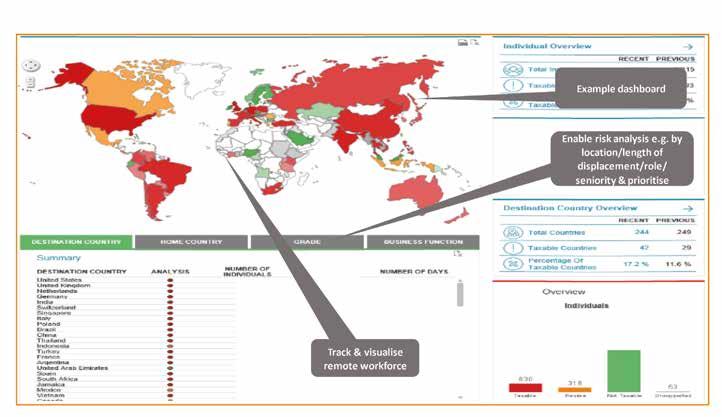
13 minute read
Remote Working: Setting The Right Strategy
In recent years, many employers have seen a steady increase in remote working requests, driven by the employee looking to combine a successful career with a more balanced lifestyle. Whether this is as a result of the millennial challenge to a traditional approach to work-life balance, the increased importance of wellbeing, or trying to fit a busy work schedule in with the challenges of family life, many businesses have already started to take steps to introduce a more agile and flexible approach to this type of request.
In the current environment, these changing demands have now been tried and tested worldwide with a scale and rapidity never previously anticipated. At the start of the COVID-19 pandemic, remote working on-mass seemed to be a temporary necessity for both employers and employees but evolved in a short period of time into the “new normal”. This "new normal" is viewed by some as an improvement to the predominantly site-based, fixed working location of prelockdown culture. According to Deloitte research, 54% of people in the UK currently working from home because of the lockdown, say they would like to work from home more often than they did before lockdown once restrictions are fully lifted. Just one in 10 say they plan to work from home less often than they did before lockdown (1) .
The future of work has rapidly accelerated, and organisations are seeing a huge opportunity to reimagine work, workforce and the workplace.
Supporting the future of work has moved up the corporate agenda. For some parts of the business and for some roles, where work is done may become location-agnostic and there will be an increased focus on how work is done, leveraging robotics and automation, digital capabilities, connected platforms, tools and techniques. For many organisations, a key question is: How can we build on our 2020 remote working ‘experiment’ to harness benefits for our longterm employment strategy?
Some large corporations have already publicly announced their new remote working stance, whilst others are beginning to explore how a broader remote working approach could be embedded as part of their longer-term talent strategy, increasing diversity through access to a wider talent pool. Where there is an international element, complexities inevitably increase. As we have seen through the pandemic, crossborder remote working can be enabled, but it can give rise to significant challenges and risks without appropriate assessment and mitigating actions.
Human Resources and Global Mobility functions should be well positioned to
Figure 1 – The future of Work through three highly interdependent disruptors; work, workforce and workplace, Deloitte LLP
assist in driving the remote working agenda, capitalising on lessons learnt from this forced period of remote working, and evolving current policy so that it is available as a key tool for the wider business strategy as companies look to recover from the impact of the pandemic.
Remote Working - Lessons learnt And Short-Term Actions COVID-19 caused major disruption to “business as usual”, combined with a significant displacement of personnel globally. Whilst global mobility teams sought to identify as a priority the whereabouts of international assignees, assessing safety and compliance risks, many regular (“nonassignee”) employees have been working remotely out of location – some for many months, basing themselves in other locations, e.g. to be with family overseas or to care for relatives. Displacements are varied – some may be authorised, some unauthorised and others ‘unknown’, where individuals have not yet updated their current place of work.
As businesses approach the last quarter of 2020, the questions below highlight some of the essential and immediate cross-functional aspects to assess and action: • Are you aware of employees (assignees and non-assignees) that are displaced outside of their normal work location due to COVID-19? Who is displaced, where and for how long? Which employees may have exceeded 183 days of displacement (or will shortly exceed this threshold) potentially impacting a whole spectrum of areas not just restricted to tax residence? • Is anyone working without the proper immigration or regulatory permissions? • Have you considered the type of roles and nature of the work being performed?
Do you have a Permanent Establishment/ corporate presence risk (for corporate or indirect tax purposes) where someone is working in another location, which could expose company profits to taxation in another country? Have any employees triggered employment tax/social security liabilities and payroll/ registration obligations for the company and/ or the individual? What are the mandatory requirements to address by year-end? As regards policy and compliance authorisation - what is the company’s and the individual’s responsibility? Have you assessed any associated costs to avoid “surprises”? Have any employees acquired new or different employment rights by virtue of working outside of their normal location? Are there additional local employment obligations that need to be considered (e.g. in relation to health and safety)? Are any displaced employees creating data protection/security risks or obligations by working remotely? Are your business protections (e.g. obligations of confidentiality and/or non-competition) in relation to displaced employees still valid and enforceable? Are employees still covered for medical insurance purposes if they are working overseas without an international policy? What is the impact on other insurances like life cover and pension provision? Have you adapted your Work From Home, remote working, business travel policies and governance frameworks? Is a workforce review being undertaken, including categorisation of roles to asses those which can be performed remotely on a sustainable basis? Are you prepared for what happens in the event of a second wave? Do you have a clear communications strategy and plan?

Whilst some countries introduced limited COVID-19 easements in respect of tax and social security, with the passage of time these have diminished in applicability. Some individuals have already exceeded 183 days of displacement (or will shortly exceed this threshold), potentially reducing the availability of relief under double tax treaties. With government revenues under significant pressures, authorities will look to apply the existing rules and regulations more strictly. Identifying/re-identifying displaced worker cases is essential to enable businesses across the globe to assess and action their mandatory compliance actions, identifying increased and unbudgeted costs, documenting decisionmaking and policy exceptions.
The lessons learnt in 2020 will be important in informing future business strategy as organisations look at the possibilities of a longer-term approach to remote working.
Remote Working - A LongerTerm Strategic Approach The application of remote working will vary significantly from organisation to organisation and some may find a full or partial return to the workplace is their preferred approach. However, for those who wish to pursue it, the impact of implementing a successful global remote working approach could be far reaching.
Adopting international remote working as part of an organisation’s long-term business and talent strategy may lead to a number of benefits such as attraction and retention of a broader, diverse talent pool; increased employee experience through increased work-life flexibility; cost savings, for example, through reduced or re-imagined office space.
Whilst remote working is not an option for some roles because the nature of the work means it can only be performed on
site or in a certain location, the pandemic has shown that some jobs can be done remotely, leveraging digital capabilities. Businesses may want to take the opportunity now to commence a broader operational workforce review to assess those roles which can be performed remotely on a sustainable basis, identifying the extent that additional support is needed from a technology, infrastructure, training, and wellbeing or performance management perspective.
From an employee mobility perspective, this could lead to a new suite of policy types with staff undertaking roles outside of their usual location either employed remotely, or deployed “virtually” or potentially a hybrid arrangement involving some periods of “on the ground” work and associated business travel.
When implementing a longer-term remote working programme, it is essential to adopt a holistic approach which incorporates crossfunctional requirements ensuring alignment across subject matter expert groups including HR, Talent, Global Mobility, Corporate Tax and Employment Tax, Immigration and Employment Law, Reward, Finance and Data/ Technology teams. This will ensure that the programme is not only fit for purpose from a talent and business perspective, but equally places a solutions-oriented focus on addressing the current and future tax, legal and immigration risks.
A triage process is necessary to enable informed decision-making and the implementation of risk-based solutions, protocols and processes to meet the demand of the new ways of working.
Leaders should consider the following questions when considering remote work as part of future workforce strategy: (see table). It will be essential to put in place a clear framework and operating guardrails when implementing a remote-working programme. At an operational level, employers will need to ensure process, systems and vendors can manage remote employees across jurisdictions. Tracking of remote workers will be key in identifying and managing risk.
Four key steps can be identified to support organisations to successfully implement a longer-term remote working strategy: 1. Assess the feasibility of remote working by reviewing business needs and requirements, talent integration, job roles and people and compliance exposure and risks. 2. Define the purpose of remote working - what is the organisation’s remote work philosophy? What should remote working be able to achieve for the business? Are there any target geographies or certain types of roles that this would be suitable or unsuitable for? What is the preferred timeline for implementation – big bang or a phased approach? 3. Design and test the infrastructure to execute your approach including HR/Policy
How does our approach to remote workers fit within our broader Talent Strategy?
Should employees be permitted to work from any location or just from ‘home’?
What is the remote work approval process including sign-off for any additional costs?
Are any HR information (HRIS) changes required?
How frequently can individuals change their remote work location?
Should remote working be offered to all personnel including new hires, or only for ‘established employees’?
What changes are needed to global rewards and benefits programs for remote workers? For instance, benchmarking to local salary and benefits of the remote work location for nonassignments? Consideration of international or regional pay scales?
What should a remote working or virtual assignment policy include and exclude?
What should the company be responsible for and what should be the employee’s responsibility? Tax/Social Security
How will employees be tracked and are systems equipped to recognise different living vs. working jurisdictions domestically and internationally?
What happens from a corporate Permanent
Establishment perspective when an employee is located in one country but working ‘for’ an entity in another? What are the risks/ mitigations?
Should specific roles or locations be excluded from remote working arrangements because they create unmanageable risk or unacceptable costs for the business? Which roles/ locations require additional levels of investigation and approval?
What are the mandatory employer and employee compliance requirements?
How to implement a process to ensure that tax and social security is withheld/paid in the right location?
Ensuring that clear cost projections are performed, where relevant, to ensure
‘no surprises’ approach for the business as income tax and social security costs can vary considerably.
Assessing the taxability of benefits and equity across jurisdictions and especially pension implications, which can be complex. Legal/Risk/Reward • What is the company’s tolerance for legal and compliance risk? For example, are there “no go” locations because of risk? • H a v e i m m i g ra t i o n considerations been a sse sse d i n c l u d i n g employees’ rights to work in a particular location? • Do we understand health and safety requirements? • Is there already an entity registered in the location from where the employee wishes to work? Or, is there a requirement for the entity to register in the remote work location? Should alternative deployment options be considered e.g. via a Global Employment
Company? • H ave e m p l oy m e n t c o n t ra c t s , w h e r e applicable, been reviewed including jurisdiction and employment law requirements according to the remote work location? • Have the implications of changes to employment terms and remuneration been assessed? • How will intra-company agreements be adjusted and cross charging handled when costs are borne by one entity, but the employee is employed by another? • Is the location safe from an intellectual property standpoint?
technology, tools, tracking and analytics, policy and reward approaches, talent management support and governance frameworks. 4. Implement the programme with a robust change management, training and communications approach which is stakeholder targeted and clearly articulates the benefits and compliance considerations to be aware of.
What next? of work is yet to be fully defined. However, the opportunity created by the necessity to work from home over recent months is clear. Indeed, according to our research, 55% of workers believe that their colleagues are just as, if not more, productive now than before lockdown.
Improved management of the workforce has always been high on the corporate agenda. However, leaders are increasingly looking at remote working as a potential solution to improve business efficiencies in terms of employee productivity, improved flexibility and reduced costs. It is imperative that any longer-term remote working programme engages cross-functional expertise, but HR and Global Mobility teams are well placed to leverage the learnings from their recent The role of a remote workforce in the future
experiences to drive forward this agenda.
References: (1) Research by Ipsos MORI on behalf of Deloitte
LLP, screening a nationally representative quota sample of 2,213 UK adults, filtered to a sample of 1,321 workers aged 16-75, using its Online Omnibus. Fieldwork took place between 14th and 18th May 2020. Data
has been weighted to the known offline population proportions for age within gender, employment status and social grade as well as government office region. Percentages have been rounded to the nearest whole percentage. https://www2.deloitte.com/

uk/en/pages/consulting/articles/workingduring-lockdown-impact-of-covid-19-onproductivity-and-wellbeing.html.
RUMI DAS Director, Global Workforce Transformation, Deloitte LLP D: +44 20 7007 0433 rudas@deloitte.co.uk


DEBBIE WARDLE Director, Global Employer Services, Deloitte LLP D: +44 20 7007 1805 djwardle@deloitte.co.uk

ROBYN IRELAND Associate Director, Global Employer Services, Deloitte LLP D: +44 20 7303 5485 roireland@deloitte.co.uk
DELOITTE’S GLOBAL WORKFORCE PRACTICE Deloitte’s Global Workforce team partners with organisations to establish future-proof global workforce strategies, tailored to client specific business and talent objectives. We embrace design thinking and are data driven to help clients reimagine and transform their approach to talent mobility, focusing on areas including policy and process design, strategic and operational transformation, global talent strategies, digital innovation, planning and deployment, and workforce analytics. Find out more here www.deloitte.co.uk/globalworkforce. This publication has been written in general terms and we recommend that you obtain professional advice before acting or refraining from action on any of the contents of this publication. Deloitte LLP accepts no liability for any loss occasioned to any person acting or refraining from action as a result of any material in this publication. Deloitte LLP is a limited liability partnership registered in England and Wales with registered number OC303675 and its registered office at 1 New Street Square, London EC4A 3HQ, United Kingdom. Deloitte LLP is the United Kingdom affiliate of Deloitte NSE LLP, a member firm of Deloitte Touche Tohmatsu Limited, a UK private company limited by guarantee ("DTTL"). DTTL and each of its member firms are legally separate and independent entities. DTTL and Deloitte NSE LLP do not provide services to clients. Please click here to learn more about our global network of member firms. © 2020 Deloitte LLP. All rights reserved.











